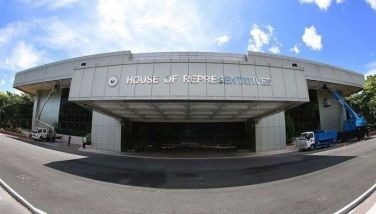There's gold in this green grass
MANILA, Philippines - It is as old as time, a part of God’s creation as a natural soil binder. But Vetiver grass has largely been ignored, and has just started to be appreciated in the last few years.
With the devastation from recent storms and typhoons – particularly “Ondoy,” “Pepeng” and “Santi” – the subject of climate change has become a very real and pressing concern in the country. With the massive flooding and landslides, both the leaders and the led are searching for solutions to avert similar destruction in the future.
Vetiver (Vetiveria zizanoides) may not be the cure-all but certainly it can help in controlling soil erosion and thus, to some extent, flooding. The secret of Vetiver grass is in its deep root system.
“The unique rooting system of the grass binds loose soil to prevent surface erosion. Its long growth anchors the soil as deep as three meters. According to studies, this increases the shear strength of the soil significantly,” reveals Mary Noah Manarang, the only internationally certified Vetiver technician in the country. She learned the technology in Thailand in 1996 when King Bhumibol Adulyadej granted her a scholarship to develop the grass. The roots of the Vetiver grow one foot every month until they reach three meters on the ninth month.
Manarang adds that the nitrogen-fixing properties of the grass also encourage the growth of other vegetation on eroded slopes.
“When planted correctly, the Vetiver hedges (the grass is planted in a row) block the water flow, thus breaking its velocity as it goes down the slope. What come down instead are gentle trickles of water filtered by the Vetiver hedgerows. This also traps the soil thus reducing siltation,” says Manarang, president of Biosolutions, the company that grows and farms Vetiver grass in nurseries all over the Philippines.
She points out that one of the causes of climate change is the increased carbon dioxide (CO2) gas emissions brought about by human activity like the burning of fossil fuel and deforestation. Vetiver grass can help in the sequestration of this carbon as with other vegetation and trees. It’s elementary knowledge that plants absorb CO2 and give out oxygen. 
Because of the many helpful properties of Vetiver, it has been called the “miracle grass.” Manarang says it is a very sturdy and resilient grass because it is both a hydrophyte (can be submerged in water for long periods) and xerophyte (can withstand extreme drought). Its roots, aside from being so long, have the strength of 75mpa, or like thin wires, such that once it’s planted, it is very hard to pull out.
Vetiver is a “behaved grass” because it is propagated by cuttings and only grows where it is planted, thus it doesn’t become an invasive weed. Though the grass produces seeds, these are sterile.
“It can grow in any type of soil, even toxic soil or soils with high metal content such as copper, manganese, aluminium, selenium, cadmium even arsenic. It can even grow on garbage, and can grow back after it is razed by fire. As I said, it is nitrogen-fixing thus it helps in conditioning the soil for other vegetation to grow,” Manarang says. She adds that that planting Vetiver is a cost-efficient technology for soil erosion control. While it is basically maintenance-free, planting the grass involves an engineering technology in order to make it effective.
Manarang considers her work at Casa Basilisa in Guinubatan, Albay – which was destroyed by the mudflow from typhoon “Reming” – as one of her most memorable projects. Manarang came to save the remaining structures of the resort along the river so that the workers could have their jobs back. They had to work fast and she had to train the people on the spot. The waiters, cooks, housekeeping staff worked under the rain, getting instructions on the job. 
“It was unforgettable because I went there right after the place was hit by the mudflow. There was no electricity, the roads were impassable and since the resort was badly damaged, I slept under a leaking roof. We had to work even as the storm was raging. There was always the danger that the river might overflow again. Vetiver was successfully combined with gabions and coconut netting technology, which resulted in a bio-engineering showcase,” she relates.
She also cites her slope protection work at the Coral Bay Nickel Mining Project in Rio Tuba, Palawan, “the biggest contiguous area we have planted with Vetiver. The whole slope is about two hectares and more than 200,000 plants were used on the slope to protect it from surface erosion.”
Manarang, a Political Science major from the University of the Philippines in Manila, admits that before becoming the country’s “Vetiver Queen,” she was not a plant or garden person.
When she left UP in 1991, she wanted to pay back the subsidized education that she got from the state university by working a year or two for the government before going to law school. She ended up in the Department of Environment and Natural Resources working for Secretary Victor Ramos. At first, she remembers, she was doing work related to her course, which was all paper work for policy-related matters. 
Later on she got exposed to environmental projects that the Department was doing. “I got involved in a forestry project funded by a foreign grant and that’s when I experienced hands-on how trees grow from seeds and I was fascinated how an almost microscopic seed of Eucalyptus and a peanut-sized seed of Gmelina can grow to a tall tree in a matter of months. I saw how a barren dry mountain can become so green and filled with wildlife after the trees have grown,” she enthuses. “I decided to stay longer as I was enjoying my job. In 1996, I went on a study grant for Vetiver grass sponsored by the Chaippatana Foundation of HM King Bhumibol Adulyadej of Thailand.”
This trip to Thailand was the turning point in her career. She just knew that she was not going to pursue law anymore but instead would be advocating the use of this grass and would be working in the environment field. Recently, for her efforts to popularize Vetiver in the country, Manarang got the highest recognition from Vetiver Network International, an organization based in Washington D.C. that recognizes technical excellence of Vetiver grass technology consultants worldwide.
Manarang was certified Class 1 consultant for Vetiver grass technology in four fields: propagation, slope stabilization, erosion control and rehabilitation of contaminated lands. She is the first Filipino and one of only 23 certified Class 1 Vetiver specialists worldwide. She is also the youngest among the elite group of respected scientists and PhD holders, although she almost sheepishly points out, “I am a Political Science major.” 
“Every thing I know about Vetiver is from training and hands on experience. The award, personally, is very significant because after 12 years of working with Vetiver, my efforts were finally recognized,” Manarang beams.
Since it is labor intensive, a lot of the cost of propagation goes to labor rather than materials, Manarang says. She is happy that it can provide livelihood to people in the communities where she plants. She makes it a point to use local labor and propagate on site whenever she has projects in the provinces.
The first time she experimented planting Vetiver on a half-hectare of land in her family rice field in Pampanga in 1997, the farmers in the neighborhood thought she had lost her mind. A few months after, container vans came to transport the harvested Vetiver to Manarang’s first soil erosion control project in Kalibo, Aklan. The farmers stopped laughing and found the value in growing the grass.
“Unless you put commercial value in the grass, people will not appreciate it,” Manarang says. “I was giving the grass away before but still nobody wanted it.”
But now, with the flooding and landslides happening all too often, Vetiver has shown that there indeed is gold in green – Vetiver green.
For more information, call Biosolutions at 5349780 or email [email protected] or log on to www.biosolutions.com.ph
- Latest
- Trending



















